Consumer Decision Making Process
VerifiedAdded on 2019/10/18
|22
|4510
|243
Report
AI Summary
The consumer decision-making process involves various stages including Lexicographic rule, Experience and memory, Brand preference, Word of mouth, The Internet, Intermediaries or agencies, and Cybermediaries. The Lexicographic rule states that consumers choose the most important criteria to them and only consider brands that pass this criteria. Once the consideration set is formed, the consumer will move on to the next most important attribute until they make a decision.
Contribute Materials
Your contribution can guide someone’s learning journey. Share your
documents today.
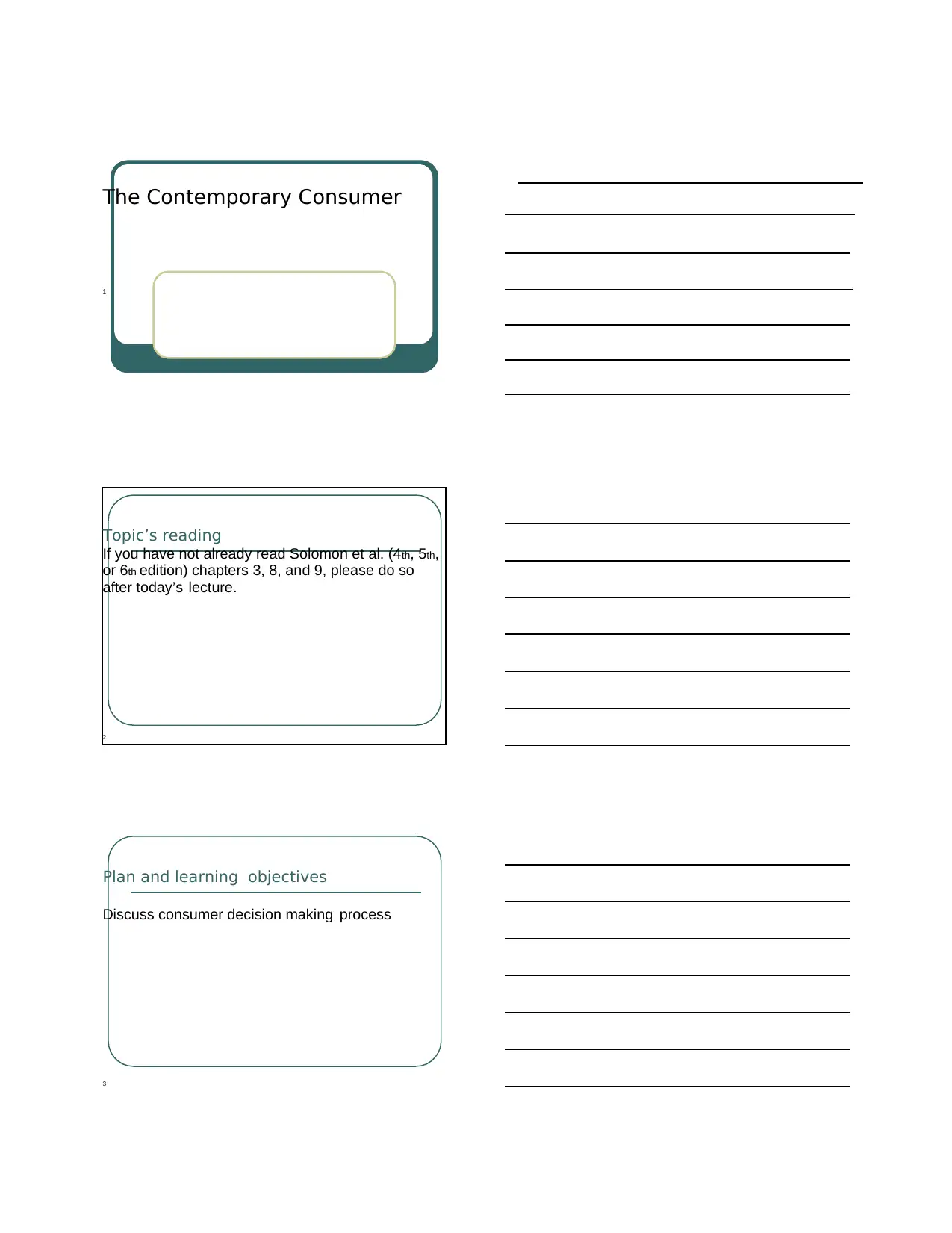
Topic’s reading
If you have not already read Solomon et al. (4th, 5th,
or 6th edition) chapters 3, 8, and 9, please do so
after today’s lecture.
2
Plan and learning objectives
Discuss consumer decision making process
3
The Contemporary Consumer
1
If you have not already read Solomon et al. (4th, 5th,
or 6th edition) chapters 3, 8, and 9, please do so
after today’s lecture.
2
Plan and learning objectives
Discuss consumer decision making process
3
The Contemporary Consumer
1
Secure Best Marks with AI Grader
Need help grading? Try our AI Grader for instant feedback on your assignments.
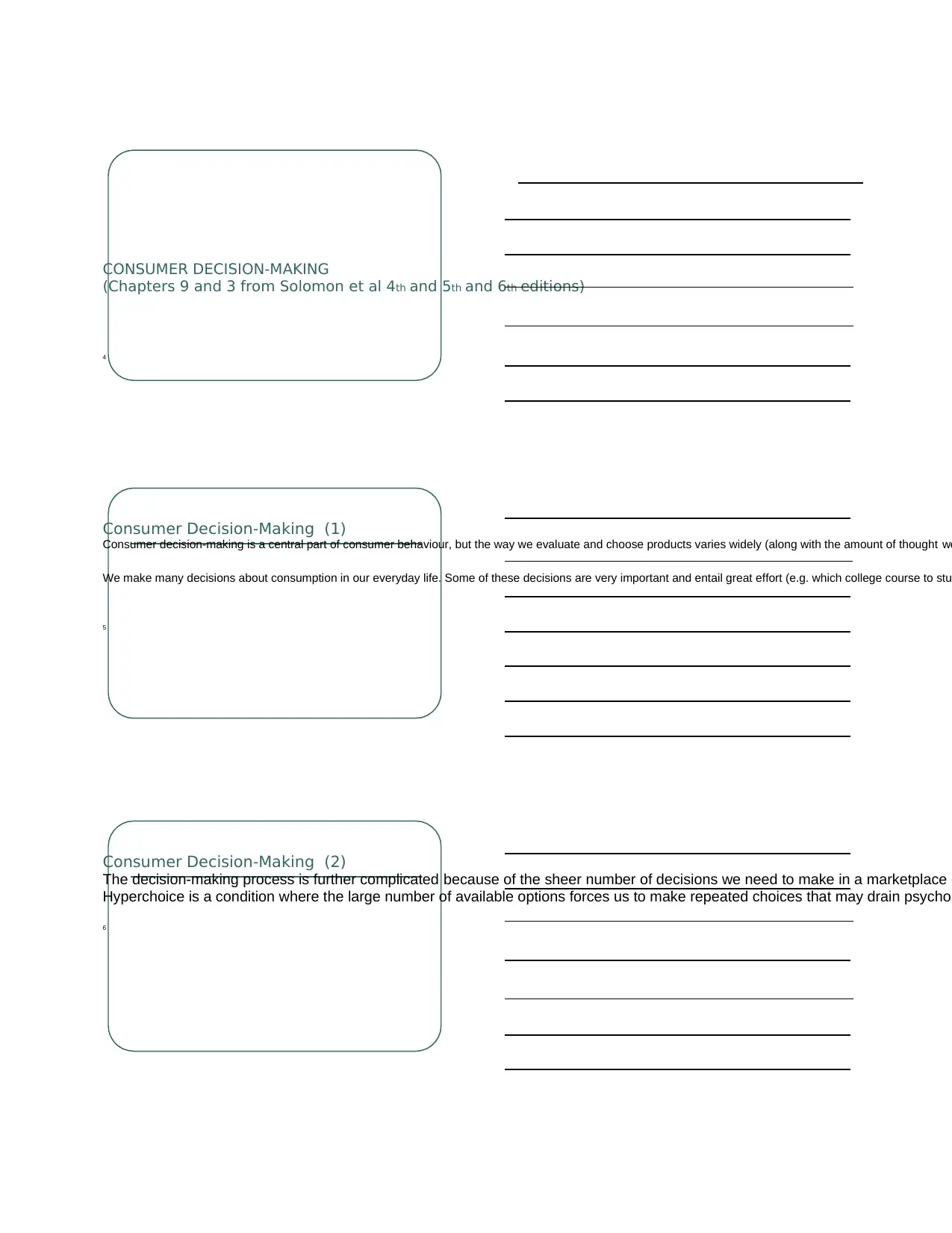
CONSUMER DECISION-MAKING
(Chapters 9 and 3 from Solomon et al 4th and 5th and 6th editions)
4
Consumer Decision-Making (1)
Consumer decision-making is a central part of consumer behaviour, but the way we evaluate and choose products varies widely (along with the amount of thought we
We make many decisions about consumption in our everyday life. Some of these decisions are very important and entail great effort (e.g. which college course to stu
5
Consumer Decision-Making (2)
The decision-making process is further complicated because of the sheer number of decisions we need to make in a marketplace e
Hyperchoice is a condition where the large number of available options forces us to make repeated choices that may drain psychol
6
(Chapters 9 and 3 from Solomon et al 4th and 5th and 6th editions)
4
Consumer Decision-Making (1)
Consumer decision-making is a central part of consumer behaviour, but the way we evaluate and choose products varies widely (along with the amount of thought we
We make many decisions about consumption in our everyday life. Some of these decisions are very important and entail great effort (e.g. which college course to stu
5
Consumer Decision-Making (2)
The decision-making process is further complicated because of the sheer number of decisions we need to make in a marketplace e
Hyperchoice is a condition where the large number of available options forces us to make repeated choices that may drain psychol
6
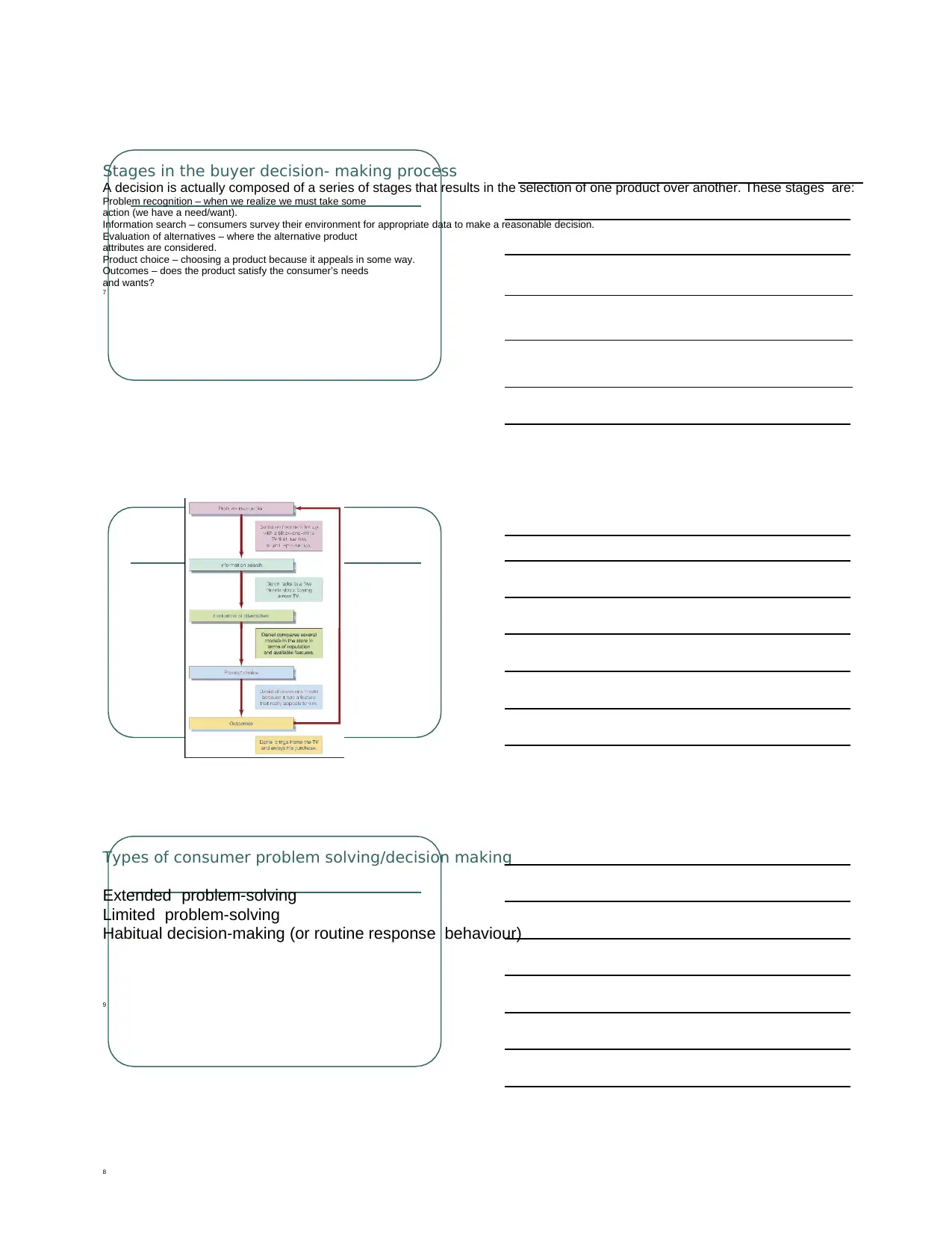
Types of consumer problem solving/decision making
Extended problem-solving
Limited problem-solving
Habitual decision-making (or routine response behaviour)
9
Stages in the buyer decision- making process
A decision is actually composed of a series of stages that results in the selection of one product over another. These stages are:
Problem recognition – when we realize we must take some
action (we have a need/want).
Information search – consumers survey their environment for appropriate data to make a reasonable decision.
Evaluation of alternatives – where the alternative product
attributes are considered.
Product choice – choosing a product because it appeals in some way.
Outcomes – does the product satisfy the consumer’s needs
and wants?
7
8
Extended problem-solving
Limited problem-solving
Habitual decision-making (or routine response behaviour)
9
Stages in the buyer decision- making process
A decision is actually composed of a series of stages that results in the selection of one product over another. These stages are:
Problem recognition – when we realize we must take some
action (we have a need/want).
Information search – consumers survey their environment for appropriate data to make a reasonable decision.
Evaluation of alternatives – where the alternative product
attributes are considered.
Product choice – choosing a product because it appeals in some way.
Outcomes – does the product satisfy the consumer’s needs
and wants?
7
8
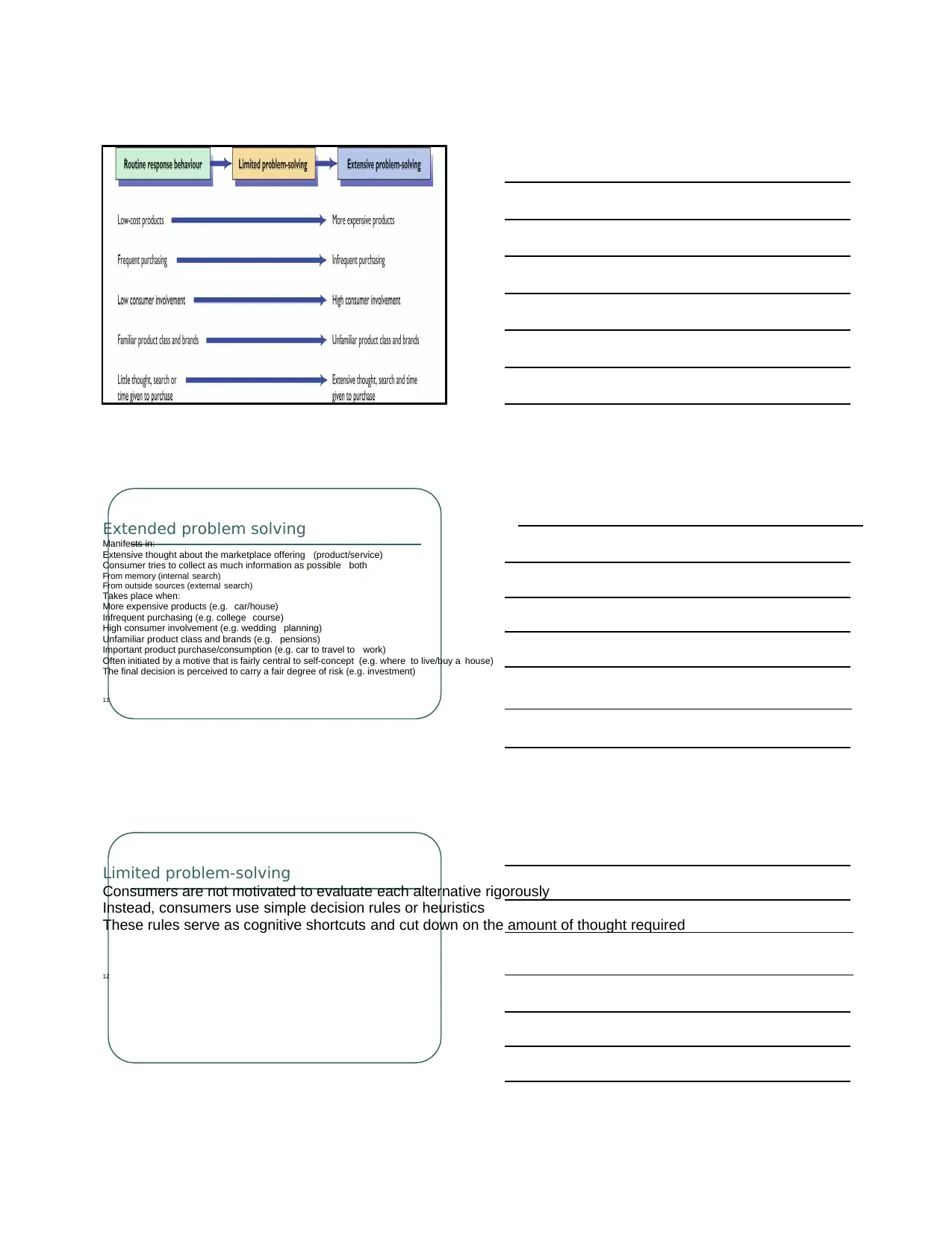
10
Extended problem solving
Manifests in:
Extensive thought about the marketplace offering (product/service)
Consumer tries to collect as much information as possible both
From memory (internal search)
From outside sources (external search)
Takes place when:
More expensive products (e.g. car/house)
Infrequent purchasing (e.g. college course)
High consumer involvement (e.g. wedding planning)
Unfamiliar product class and brands (e.g. pensions)
Important product purchase/consumption (e.g. car to travel to work)
Often initiated by a motive that is fairly central to self-concept (e.g. where to live/buy a house)
The final decision is perceived to carry a fair degree of risk (e.g. investment)
11
Limited problem-solving
Consumers are not motivated to evaluate each alternative rigorously
Instead, consumers use simple decision rules or heuristics
These rules serve as cognitive shortcuts and cut down on the amount of thought required
12
Extended problem solving
Manifests in:
Extensive thought about the marketplace offering (product/service)
Consumer tries to collect as much information as possible both
From memory (internal search)
From outside sources (external search)
Takes place when:
More expensive products (e.g. car/house)
Infrequent purchasing (e.g. college course)
High consumer involvement (e.g. wedding planning)
Unfamiliar product class and brands (e.g. pensions)
Important product purchase/consumption (e.g. car to travel to work)
Often initiated by a motive that is fairly central to self-concept (e.g. where to live/buy a house)
The final decision is perceived to carry a fair degree of risk (e.g. investment)
11
Limited problem-solving
Consumers are not motivated to evaluate each alternative rigorously
Instead, consumers use simple decision rules or heuristics
These rules serve as cognitive shortcuts and cut down on the amount of thought required
12
Secure Best Marks with AI Grader
Need help grading? Try our AI Grader for instant feedback on your assignments.
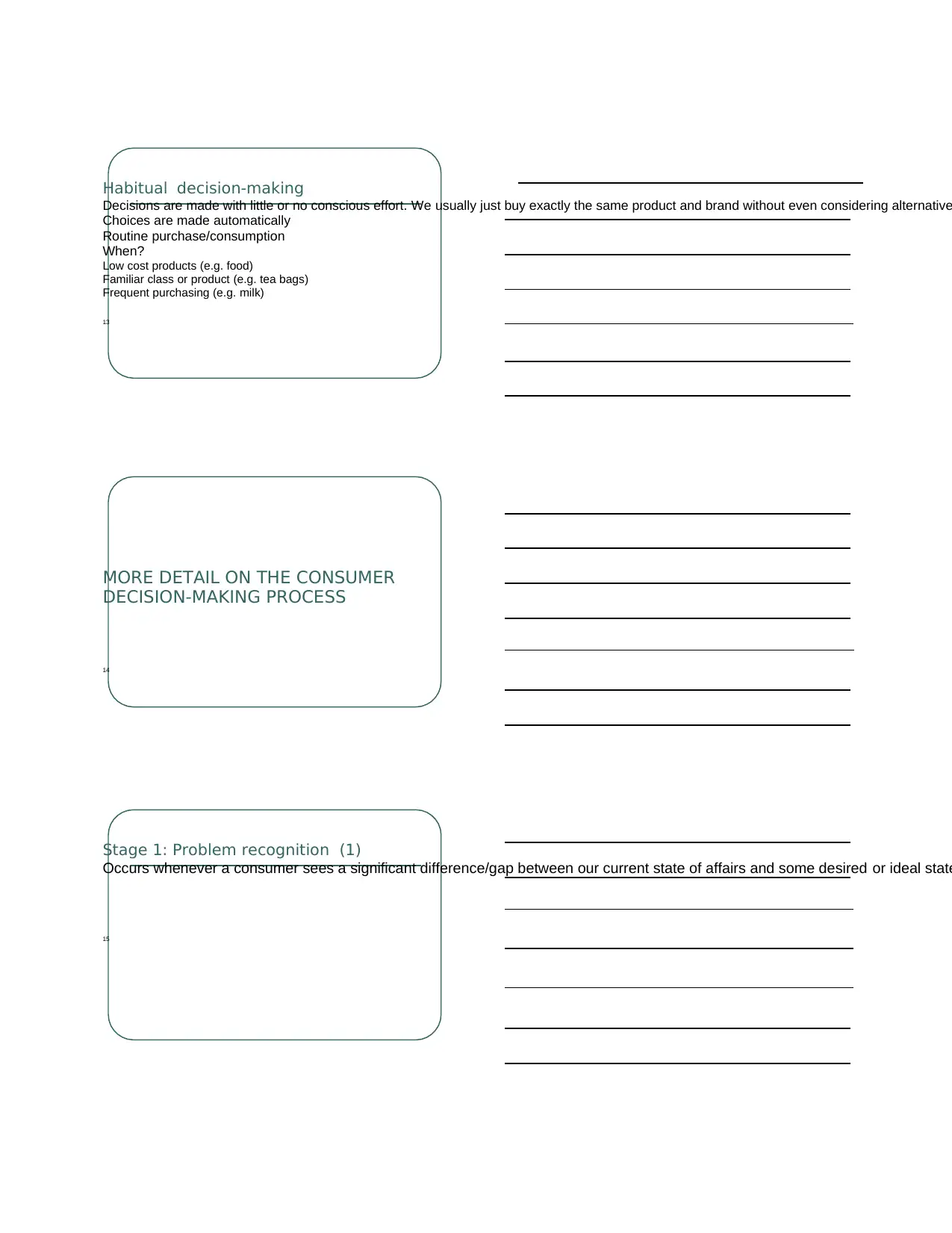
Habitual decision-making
Decisions are made with little or no conscious effort. We usually just buy exactly the same product and brand without even considering alternative
Choices are made automatically
Routine purchase/consumption
When?
Low cost products (e.g. food)
Familiar class or product (e.g. tea bags)
Frequent purchasing (e.g. milk)
13
MORE DETAIL ON THE CONSUMER
DECISION-MAKING PROCESS
14
Stage 1: Problem recognition (1)
Occurs whenever a consumer sees a significant difference/gap between our current state of affairs and some desired or ideal state
15
Decisions are made with little or no conscious effort. We usually just buy exactly the same product and brand without even considering alternative
Choices are made automatically
Routine purchase/consumption
When?
Low cost products (e.g. food)
Familiar class or product (e.g. tea bags)
Frequent purchasing (e.g. milk)
13
MORE DETAIL ON THE CONSUMER
DECISION-MAKING PROCESS
14
Stage 1: Problem recognition (1)
Occurs whenever a consumer sees a significant difference/gap between our current state of affairs and some desired or ideal state
15
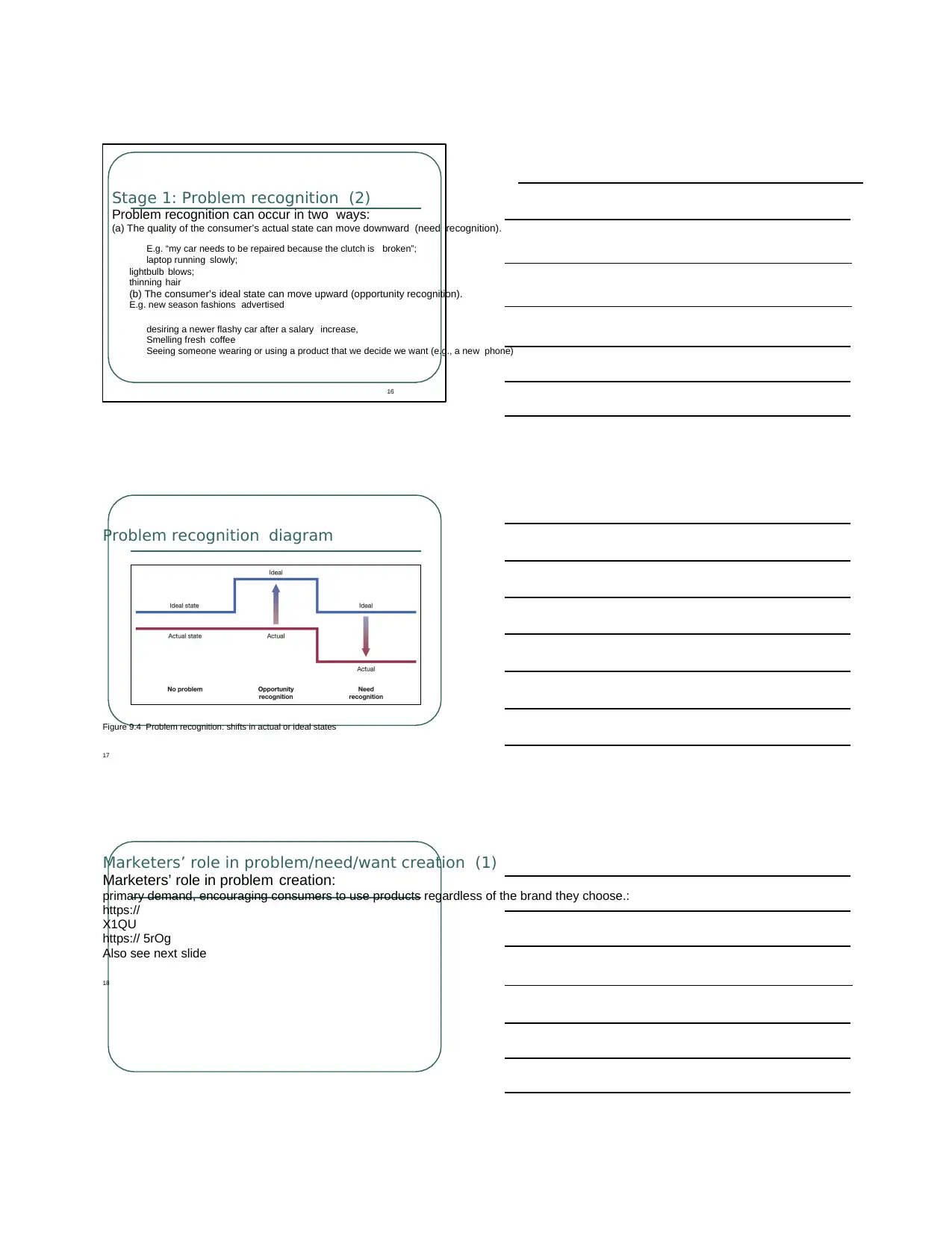
Problem recognition diagram
Figure 9.4 Problem recognition: shifts in actual or ideal states
17
Stage 1: Problem recognition (2)
Problem recognition can occur in two ways:
(a) The quality of the consumer’s actual state can move downward (need recognition).
E.g. “my car needs to be repaired because the clutch is broken”;
lightbulb blows;
thinning hair
(b) The consumer’s ideal state can move upward (opportunity recognition).
E.g. new season fashions advertised
laptop running slowly;
desiring a newer flashy car after a salary increase,
Smelling fresh coffee
Seeing someone wearing or using a product that we decide we want (e.g., a new phone)
16
Marketers’ role in problem/need/want creation (1)
Marketers’ role in problem creation:
primary demand, encouraging consumers to use products regardless of the brand they choose.:
https://
X1QU
https:// 5rOg
Also see next slide
18
Figure 9.4 Problem recognition: shifts in actual or ideal states
17
Stage 1: Problem recognition (2)
Problem recognition can occur in two ways:
(a) The quality of the consumer’s actual state can move downward (need recognition).
E.g. “my car needs to be repaired because the clutch is broken”;
lightbulb blows;
thinning hair
(b) The consumer’s ideal state can move upward (opportunity recognition).
E.g. new season fashions advertised
laptop running slowly;
desiring a newer flashy car after a salary increase,
Smelling fresh coffee
Seeing someone wearing or using a product that we decide we want (e.g., a new phone)
16
Marketers’ role in problem/need/want creation (1)
Marketers’ role in problem creation:
primary demand, encouraging consumers to use products regardless of the brand they choose.:
https://
X1QU
https:// 5rOg
Also see next slide
18
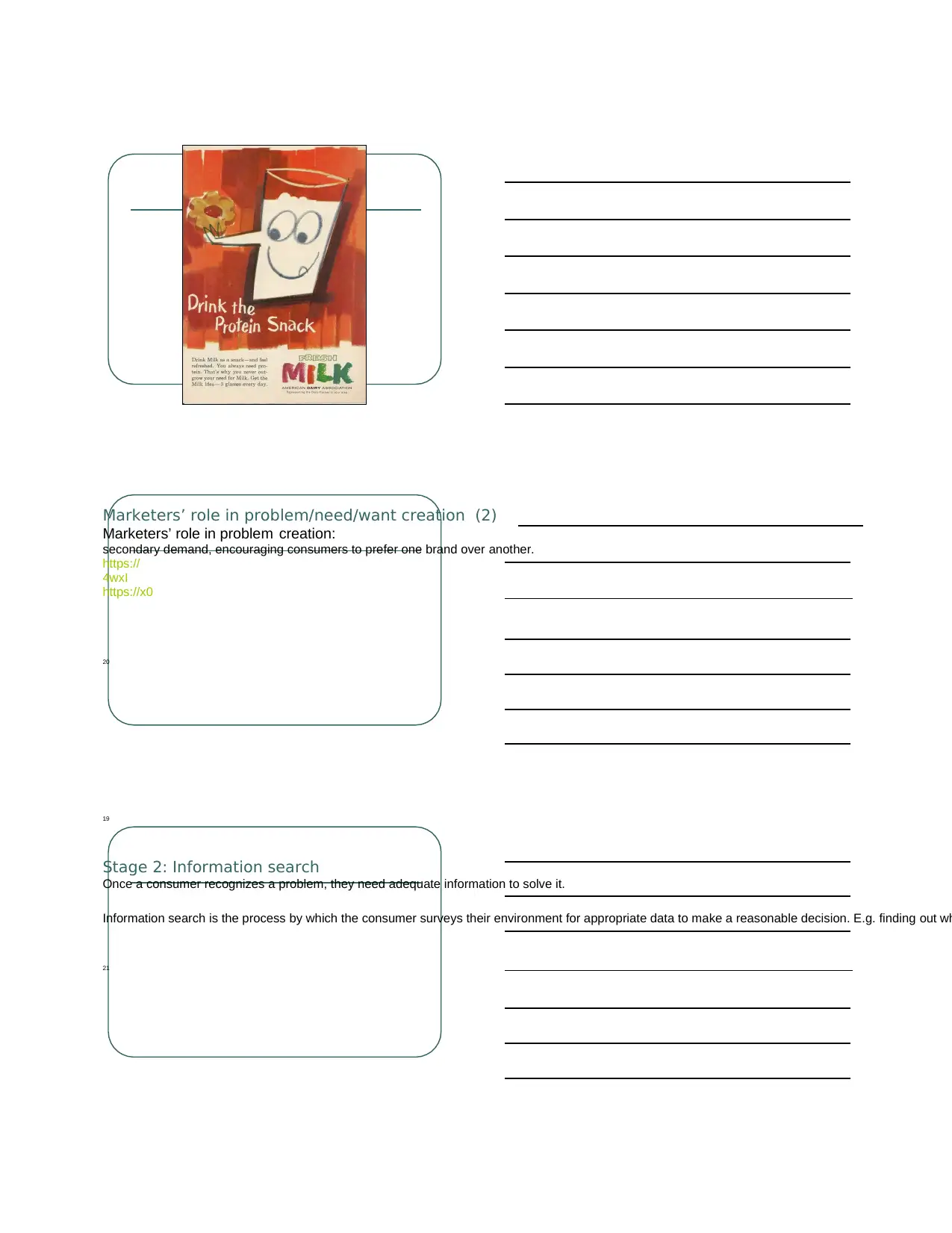
19
Marketers’ role in problem/need/want creation (2)
Marketers’ role in problem creation:
secondary demand, encouraging consumers to prefer one brand over another.
https://
4wxI
https://x0
20
Stage 2: Information search
Once a consumer recognizes a problem, they need adequate information to solve it.
Information search is the process by which the consumer surveys their environment for appropriate data to make a reasonable decision. E.g. finding out wh
21
Marketers’ role in problem/need/want creation (2)
Marketers’ role in problem creation:
secondary demand, encouraging consumers to prefer one brand over another.
https://
4wxI
https://x0
20
Stage 2: Information search
Once a consumer recognizes a problem, they need adequate information to solve it.
Information search is the process by which the consumer surveys their environment for appropriate data to make a reasonable decision. E.g. finding out wh
21
Paraphrase This Document
Need a fresh take? Get an instant paraphrase of this document with our AI Paraphraser

Stage 2: Information search – sources of information
The company (in-person interactions with staff, phone, email, web contact forms, facebook page, twitter, official website, adverts, webchat)
Websites (google, unofficial websites, youtube videos, forums, facebook pages, twitter accounts, review pages, blogs)
Competitors
Magazines/newspapers
Brochures
Agencies (e.g. insurance brokers) or consultants
Retailers (both online and offline)
Consumers (word of mouth online and offline)
22
Types of information search (1)
(1) Internal versus external search Internal search
Consumers scan their memory banks to assemble information about different product alternatives
External search
Information is obtained from advertisements, friends and people watching
23
Types of information search (2)
(2) Deliberate versus ‘accidental’ search Deliberate search
Consumers purposely/actively search for information in order to make a purchase
Accidental search
We acquire information in a passive manner. Product may not be of interest right now, but consumers learn about products due to mere exposure to inform
24
The company (in-person interactions with staff, phone, email, web contact forms, facebook page, twitter, official website, adverts, webchat)
Websites (google, unofficial websites, youtube videos, forums, facebook pages, twitter accounts, review pages, blogs)
Competitors
Magazines/newspapers
Brochures
Agencies (e.g. insurance brokers) or consultants
Retailers (both online and offline)
Consumers (word of mouth online and offline)
22
Types of information search (1)
(1) Internal versus external search Internal search
Consumers scan their memory banks to assemble information about different product alternatives
External search
Information is obtained from advertisements, friends and people watching
23
Types of information search (2)
(2) Deliberate versus ‘accidental’ search Deliberate search
Consumers purposely/actively search for information in order to make a purchase
Accidental search
We acquire information in a passive manner. Product may not be of interest right now, but consumers learn about products due to mere exposure to inform
24
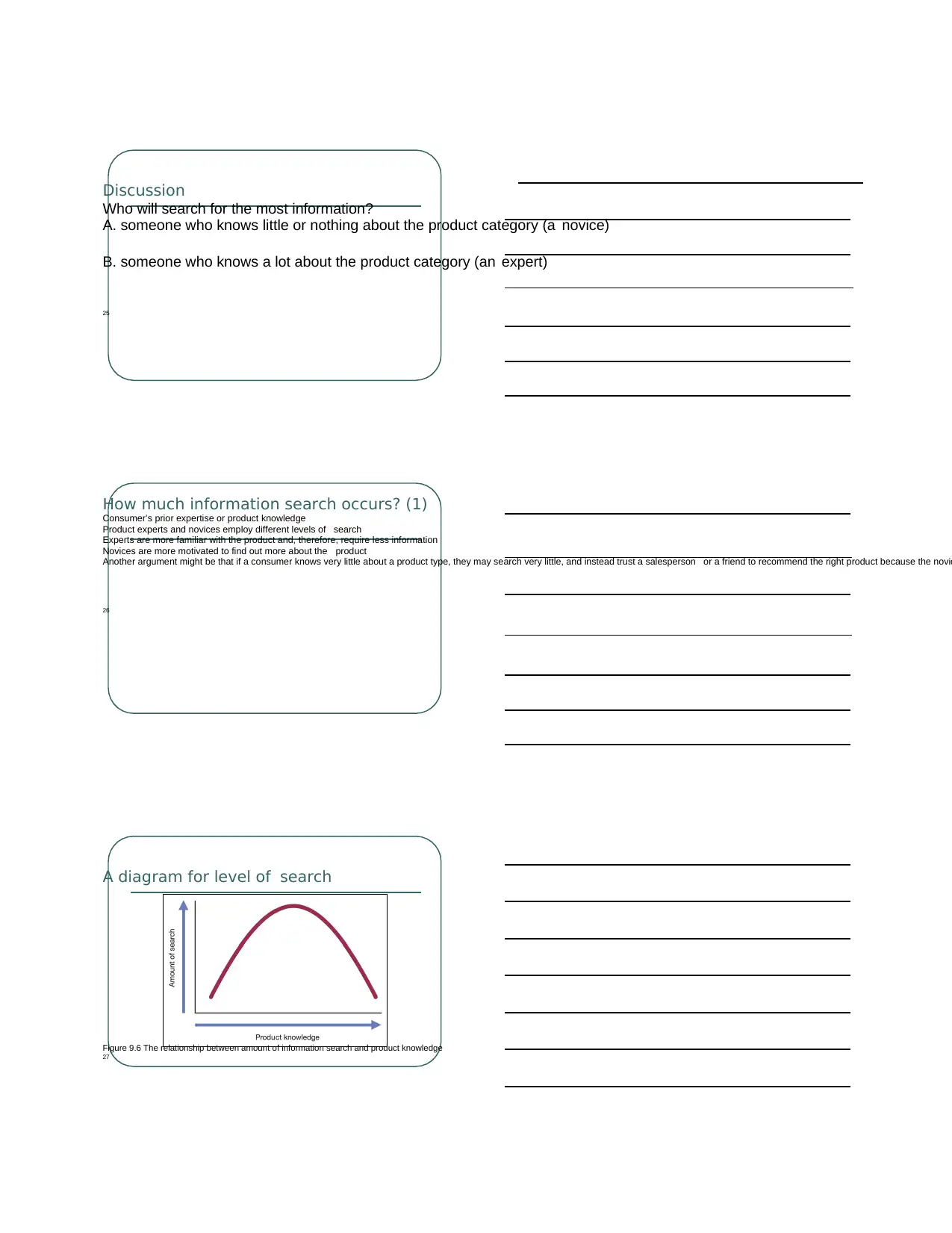
A diagram for level of search
Figure 9.6 The relationship between amount of information search and product knowledge
27
Discussion
Who will search for the most information?
A. someone who knows little or nothing about the product category (a novice)
B. someone who knows a lot about the product category (an expert)
25
How much information search occurs? (1)
Consumer’s prior expertise or product knowledge
Product experts and novices employ different levels of search
Experts are more familiar with the product and, therefore, require less information
Novices are more motivated to find out more about the product
Another argument might be that if a consumer knows very little about a product type, they may search very little, and instead trust a salesperson or a friend to recommend the right product because the novic
26
Figure 9.6 The relationship between amount of information search and product knowledge
27
Discussion
Who will search for the most information?
A. someone who knows little or nothing about the product category (a novice)
B. someone who knows a lot about the product category (an expert)
25
How much information search occurs? (1)
Consumer’s prior expertise or product knowledge
Product experts and novices employ different levels of search
Experts are more familiar with the product and, therefore, require less information
Novices are more motivated to find out more about the product
Another argument might be that if a consumer knows very little about a product type, they may search very little, and instead trust a salesperson or a friend to recommend the right product because the novic
26
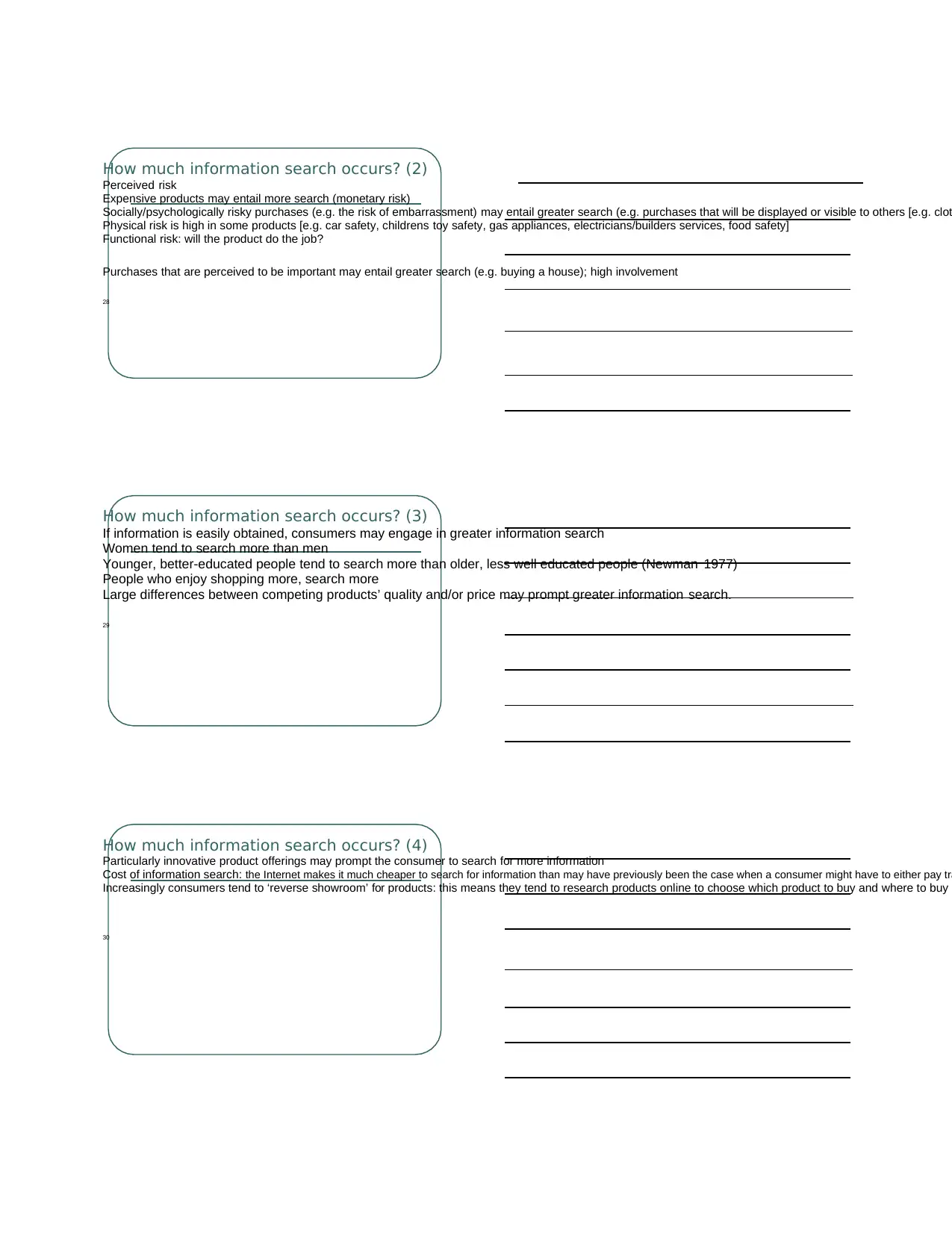
How much information search occurs? (2)
Perceived risk
Expensive products may entail more search (monetary risk)
Socially/psychologically risky purchases (e.g. the risk of embarrassment) may entail greater search (e.g. purchases that will be displayed or visible to others [e.g. clot
Physical risk is high in some products [e.g. car safety, childrens toy safety, gas appliances, electricians/builders services, food safety]
Functional risk: will the product do the job?
Purchases that are perceived to be important may entail greater search (e.g. buying a house); high involvement
28
How much information search occurs? (3)
If information is easily obtained, consumers may engage in greater information search
Women tend to search more than men
Younger, better-educated people tend to search more than older, less well educated people (Newman 1977)
People who enjoy shopping more, search more
Large differences between competing products’ quality and/or price may prompt greater information search.
29
How much information search occurs? (4)
Particularly innovative product offerings may prompt the consumer to search for more information
Cost of information search: the Internet makes it much cheaper to search for information than may have previously been the case when a consumer might have to either pay tra
Increasingly consumers tend to ‘reverse showroom’ for products: this means they tend to research products online to choose which product to buy and where to buy i
30
Perceived risk
Expensive products may entail more search (monetary risk)
Socially/psychologically risky purchases (e.g. the risk of embarrassment) may entail greater search (e.g. purchases that will be displayed or visible to others [e.g. clot
Physical risk is high in some products [e.g. car safety, childrens toy safety, gas appliances, electricians/builders services, food safety]
Functional risk: will the product do the job?
Purchases that are perceived to be important may entail greater search (e.g. buying a house); high involvement
28
How much information search occurs? (3)
If information is easily obtained, consumers may engage in greater information search
Women tend to search more than men
Younger, better-educated people tend to search more than older, less well educated people (Newman 1977)
People who enjoy shopping more, search more
Large differences between competing products’ quality and/or price may prompt greater information search.
29
How much information search occurs? (4)
Particularly innovative product offerings may prompt the consumer to search for more information
Cost of information search: the Internet makes it much cheaper to search for information than may have previously been the case when a consumer might have to either pay tra
Increasingly consumers tend to ‘reverse showroom’ for products: this means they tend to research products online to choose which product to buy and where to buy i
30
Secure Best Marks with AI Grader
Need help grading? Try our AI Grader for instant feedback on your assignments.
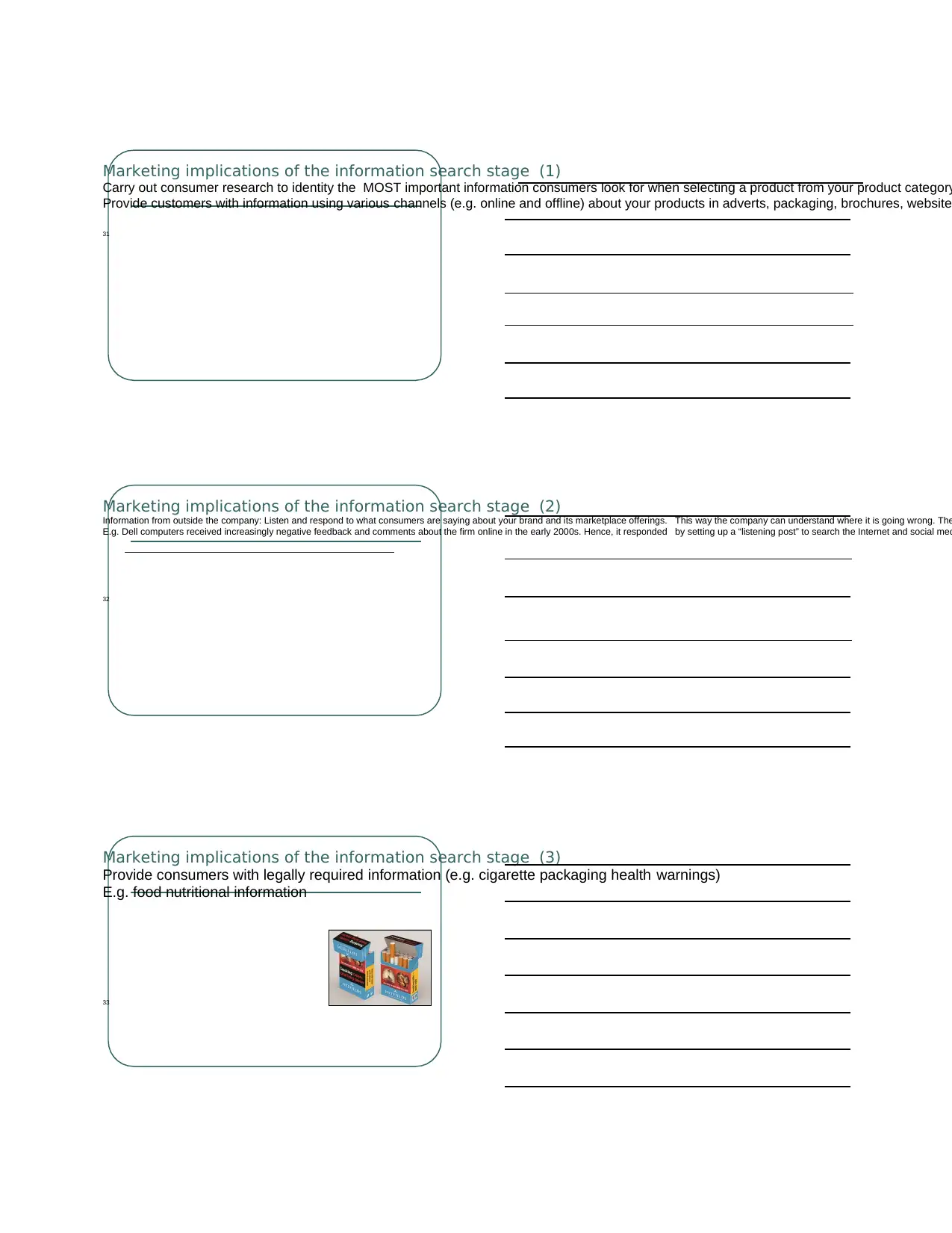
Marketing implications of the information search stage (3)
Provide consumers with legally required information (e.g. cigarette packaging health warnings)
E.g. food nutritional information
33
Marketing implications of the information search stage (1)
Carry out consumer research to identity the MOST important information consumers look for when selecting a product from your product category
Provide customers with information using various channels (e.g. online and offline) about your products in adverts, packaging, brochures, websites
31
Marketing implications of the information search stage (2)
Information from outside the company: Listen and respond to what consumers are saying about your brand and its marketplace offerings. This way the company can understand where it is going wrong. The
E.g. Dell computers received increasingly negative feedback and comments about the firm online in the early 2000s. Hence, it responded by setting up a “listening post” to search the Internet and social med
32
Provide consumers with legally required information (e.g. cigarette packaging health warnings)
E.g. food nutritional information
33
Marketing implications of the information search stage (1)
Carry out consumer research to identity the MOST important information consumers look for when selecting a product from your product category
Provide customers with information using various channels (e.g. online and offline) about your products in adverts, packaging, brochures, websites
31
Marketing implications of the information search stage (2)
Information from outside the company: Listen and respond to what consumers are saying about your brand and its marketplace offerings. This way the company can understand where it is going wrong. The
E.g. Dell computers received increasingly negative feedback and comments about the firm online in the early 2000s. Hence, it responded by setting up a “listening post” to search the Internet and social med
32
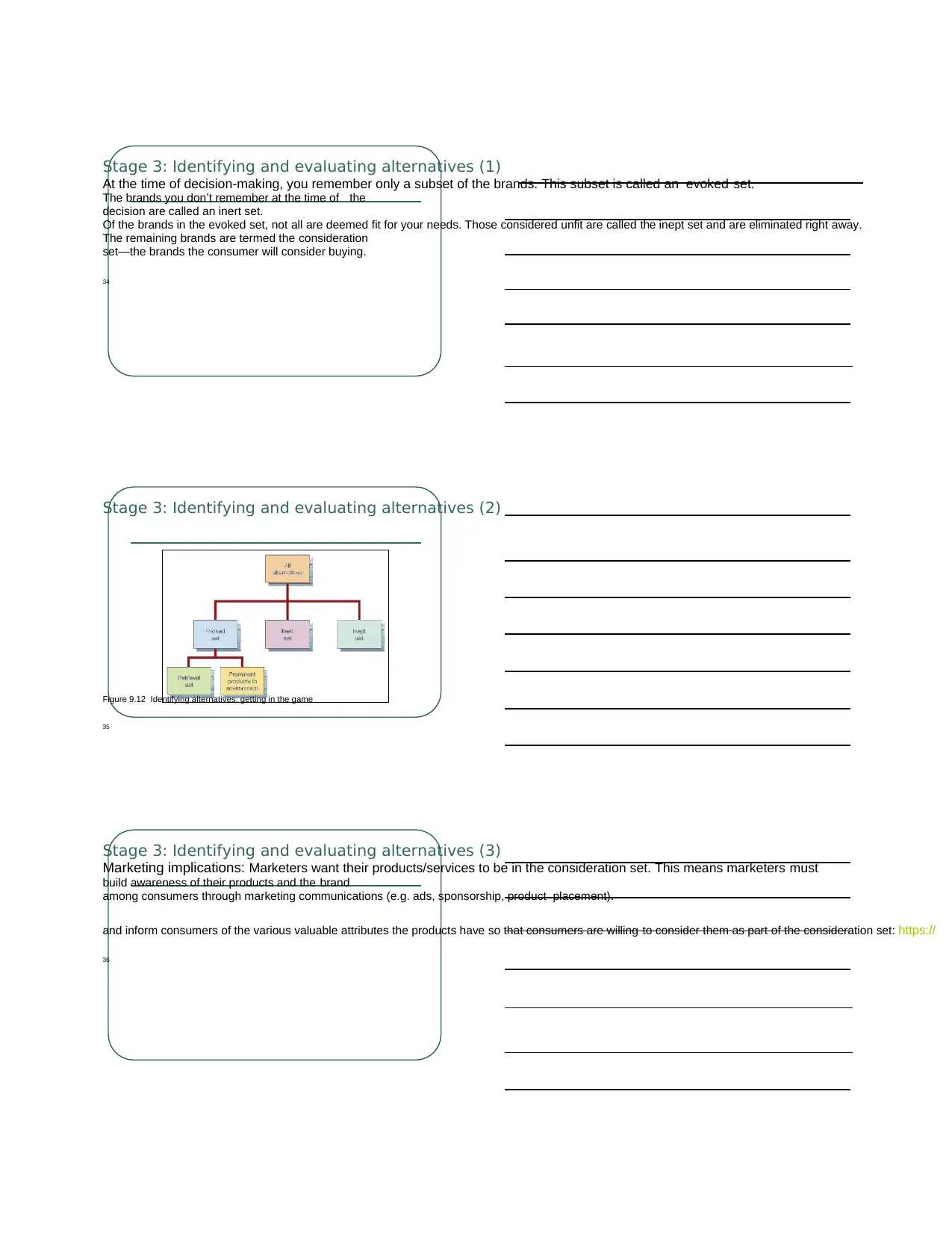
Stage 3: Identifying and evaluating alternatives (1)
At the time of decision-making, you remember only a subset of the brands. This subset is called an evoked set.
The brands you don’t remember at the time of the
decision are called an inert set.
Of the brands in the evoked set, not all are deemed fit for your needs. Those considered unfit are called the inept set and are eliminated right away.
The remaining brands are termed the consideration
set—the brands the consumer will consider buying.
34
Stage 3: Identifying and evaluating alternatives (2)
Figure 9.12 Identifying alternatives: getting in the game
35
Stage 3: Identifying and evaluating alternatives (3)
Marketing implications: Marketers want their products/services to be in the consideration set. This means marketers must
build awareness of their products and the brand
among consumers through marketing communications (e.g. ads, sponsorship, product placement).
and inform consumers of the various valuable attributes the products have so that consumers are willing to consider them as part of the consideration set: https://
36
At the time of decision-making, you remember only a subset of the brands. This subset is called an evoked set.
The brands you don’t remember at the time of the
decision are called an inert set.
Of the brands in the evoked set, not all are deemed fit for your needs. Those considered unfit are called the inept set and are eliminated right away.
The remaining brands are termed the consideration
set—the brands the consumer will consider buying.
34
Stage 3: Identifying and evaluating alternatives (2)
Figure 9.12 Identifying alternatives: getting in the game
35
Stage 3: Identifying and evaluating alternatives (3)
Marketing implications: Marketers want their products/services to be in the consideration set. This means marketers must
build awareness of their products and the brand
among consumers through marketing communications (e.g. ads, sponsorship, product placement).
and inform consumers of the various valuable attributes the products have so that consumers are willing to consider them as part of the consideration set: https://
36

39
Stage 3: Identifying and evaluating alternatives (4)
Marketing implications: Marketers want their products/services to be in the consideration set. This means marketers must
Help customers evaluate alternatives with
Competitor comparison information: Marketers can help customers to evaluate alternatives by showing/explaining to the customer that the marketer’s brand provide
37
Stage 3: Identifying and evaluating alternatives (5)
Marketing implications: Marketers want their products/services to be in the consideration set. This means marketers must
Customer service/sales interactions: where possible
have channels of communication designed to help consumers with their evaluations (e.g. customer service/sales phone line, email address, website contact form, we
Continued on the next slide
38
Stage 3: Identifying and evaluating alternatives (4)
Marketing implications: Marketers want their products/services to be in the consideration set. This means marketers must
Help customers evaluate alternatives with
Competitor comparison information: Marketers can help customers to evaluate alternatives by showing/explaining to the customer that the marketer’s brand provide
37
Stage 3: Identifying and evaluating alternatives (5)
Marketing implications: Marketers want their products/services to be in the consideration set. This means marketers must
Customer service/sales interactions: where possible
have channels of communication designed to help consumers with their evaluations (e.g. customer service/sales phone line, email address, website contact form, we
Continued on the next slide
38
Paraphrase This Document
Need a fresh take? Get an instant paraphrase of this document with our AI Paraphraser
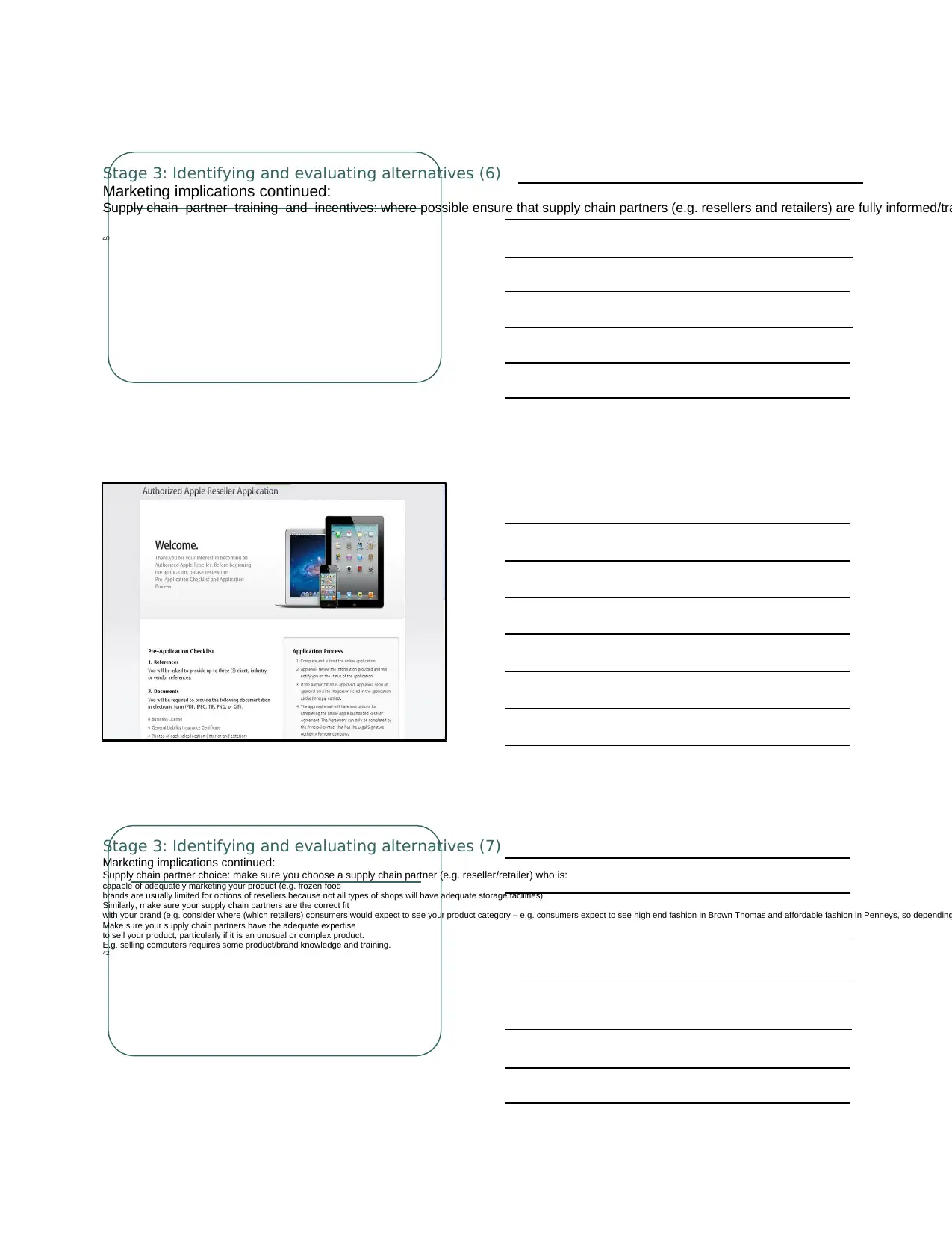
41
Stage 3: Identifying and evaluating alternatives (6)
Marketing implications continued:
Supply chain partner training and incentives: where possible ensure that supply chain partners (e.g. resellers and retailers) are fully informed/tra
40
Stage 3: Identifying and evaluating alternatives (7)
Marketing implications continued:
Supply chain partner choice: make sure you choose a supply chain partner (e.g. reseller/retailer) who is:
capable of adequately marketing your product (e.g. frozen food
brands are usually limited for options of resellers because not all types of shops will have adequate storage facilities).
Similarly, make sure your supply chain partners are the correct fit
with your brand (e.g. consider where (which retailers) consumers would expect to see your product category – e.g. consumers expect to see high end fashion in Brown Thomas and affordable fashion in Penneys, so depending
Make sure your supply chain partners have the adequate expertise
to sell your product, particularly if it is an unusual or complex product.
E.g. selling computers requires some product/brand knowledge and training.
42
Stage 3: Identifying and evaluating alternatives (6)
Marketing implications continued:
Supply chain partner training and incentives: where possible ensure that supply chain partners (e.g. resellers and retailers) are fully informed/tra
40
Stage 3: Identifying and evaluating alternatives (7)
Marketing implications continued:
Supply chain partner choice: make sure you choose a supply chain partner (e.g. reseller/retailer) who is:
capable of adequately marketing your product (e.g. frozen food
brands are usually limited for options of resellers because not all types of shops will have adequate storage facilities).
Similarly, make sure your supply chain partners are the correct fit
with your brand (e.g. consider where (which retailers) consumers would expect to see your product category – e.g. consumers expect to see high end fashion in Brown Thomas and affordable fashion in Penneys, so depending
Make sure your supply chain partners have the adequate expertise
to sell your product, particularly if it is an unusual or complex product.
E.g. selling computers requires some product/brand knowledge and training.
42
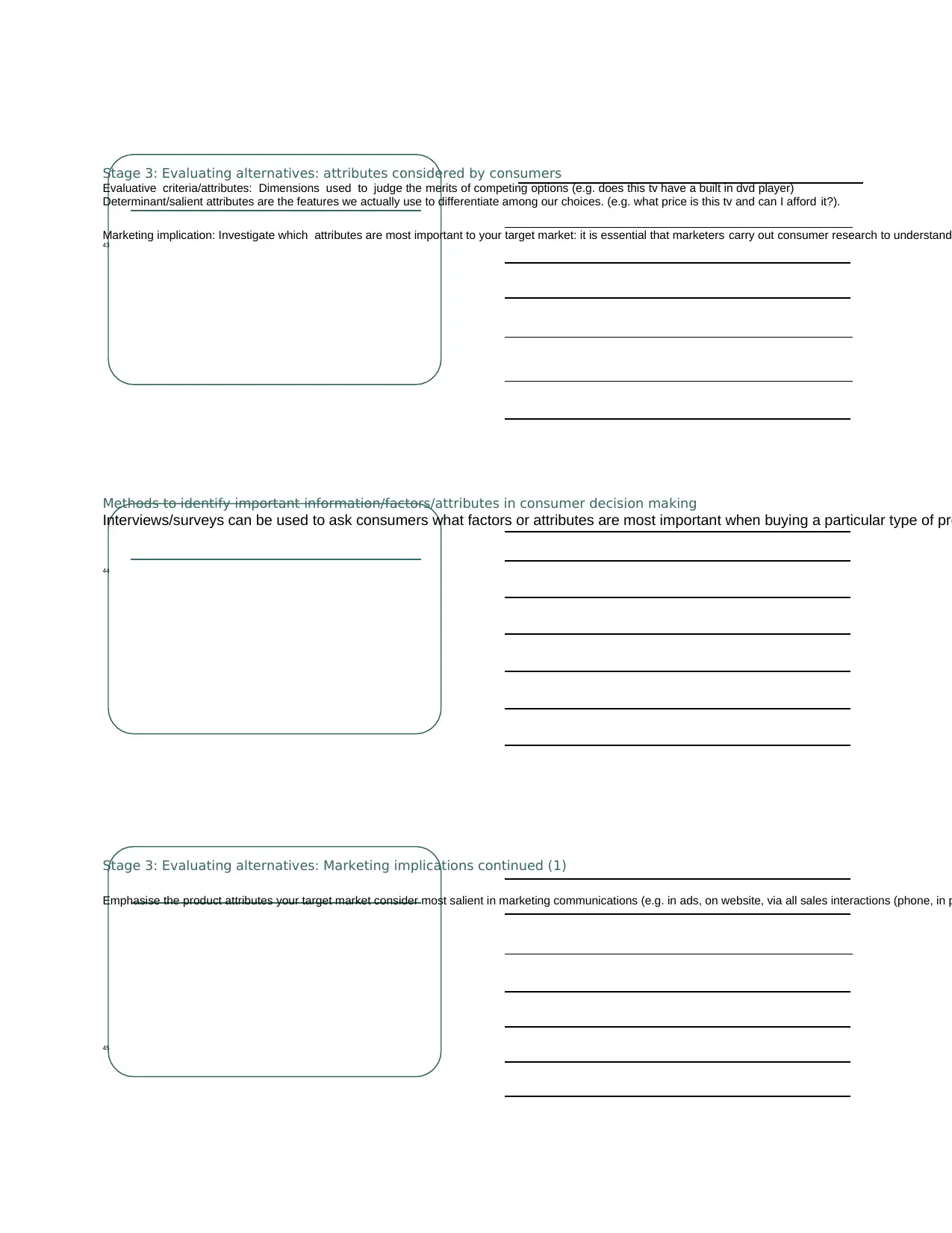
Stage 3: Evaluating alternatives: attributes considered by consumers
Evaluative criteria/attributes: Dimensions used to judge the merits of competing options (e.g. does this tv have a built in dvd player)
Determinant/salient attributes are the features we actually use to differentiate among our choices. (e.g. what price is this tv and can I afford it?).
Marketing implication: Investigate which attributes are most important to your target market: it is essential that marketers carry out consumer research to understand
43
Methods to identify important information/factors/attributes in consumer decision making
Interviews/surveys can be used to ask consumers what factors or attributes are most important when buying a particular type of pro
44
Stage 3: Evaluating alternatives: Marketing implications continued (1)
Emphasise the product attributes your target market consider most salient in marketing communications (e.g. in ads, on website, via all sales interactions (phone, in p
45
Evaluative criteria/attributes: Dimensions used to judge the merits of competing options (e.g. does this tv have a built in dvd player)
Determinant/salient attributes are the features we actually use to differentiate among our choices. (e.g. what price is this tv and can I afford it?).
Marketing implication: Investigate which attributes are most important to your target market: it is essential that marketers carry out consumer research to understand
43
Methods to identify important information/factors/attributes in consumer decision making
Interviews/surveys can be used to ask consumers what factors or attributes are most important when buying a particular type of pro
44
Stage 3: Evaluating alternatives: Marketing implications continued (1)
Emphasise the product attributes your target market consider most salient in marketing communications (e.g. in ads, on website, via all sales interactions (phone, in p
45
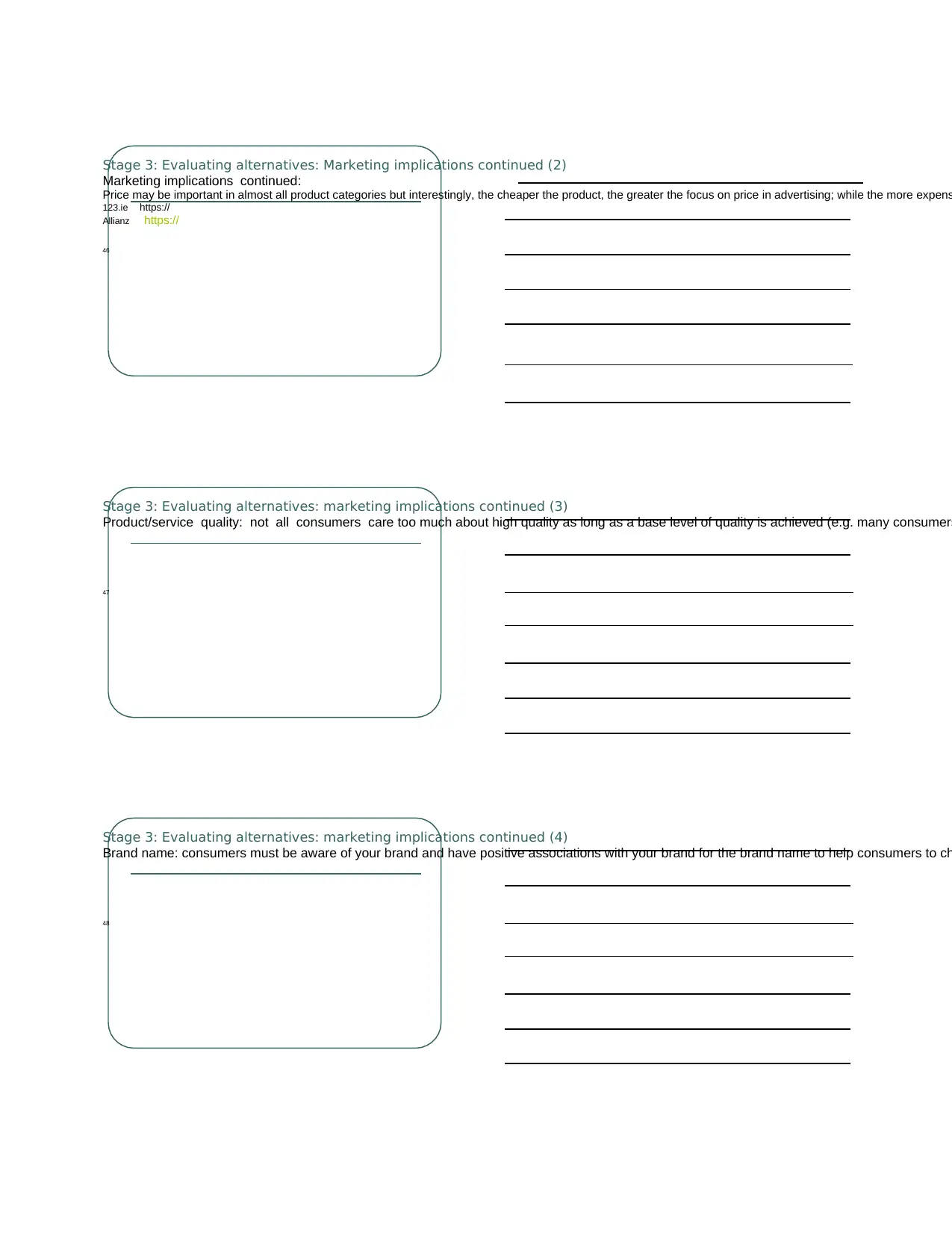
Stage 3: Evaluating alternatives: Marketing implications continued (2)
Marketing implications continued:
Price may be important in almost all product categories but interestingly, the cheaper the product, the greater the focus on price in advertising; while the more expens
123.ie https://
Allianz https://
46
Stage 3: Evaluating alternatives: marketing implications continued (3)
Product/service quality: not all consumers care too much about high quality as long as a base level of quality is achieved (e.g. many consumers
47
Stage 3: Evaluating alternatives: marketing implications continued (4)
Brand name: consumers must be aware of your brand and have positive associations with your brand for the brand name to help consumers to ch
48
Marketing implications continued:
Price may be important in almost all product categories but interestingly, the cheaper the product, the greater the focus on price in advertising; while the more expens
123.ie https://
Allianz https://
46
Stage 3: Evaluating alternatives: marketing implications continued (3)
Product/service quality: not all consumers care too much about high quality as long as a base level of quality is achieved (e.g. many consumers
47
Stage 3: Evaluating alternatives: marketing implications continued (4)
Brand name: consumers must be aware of your brand and have positive associations with your brand for the brand name to help consumers to ch
48
Secure Best Marks with AI Grader
Need help grading? Try our AI Grader for instant feedback on your assignments.
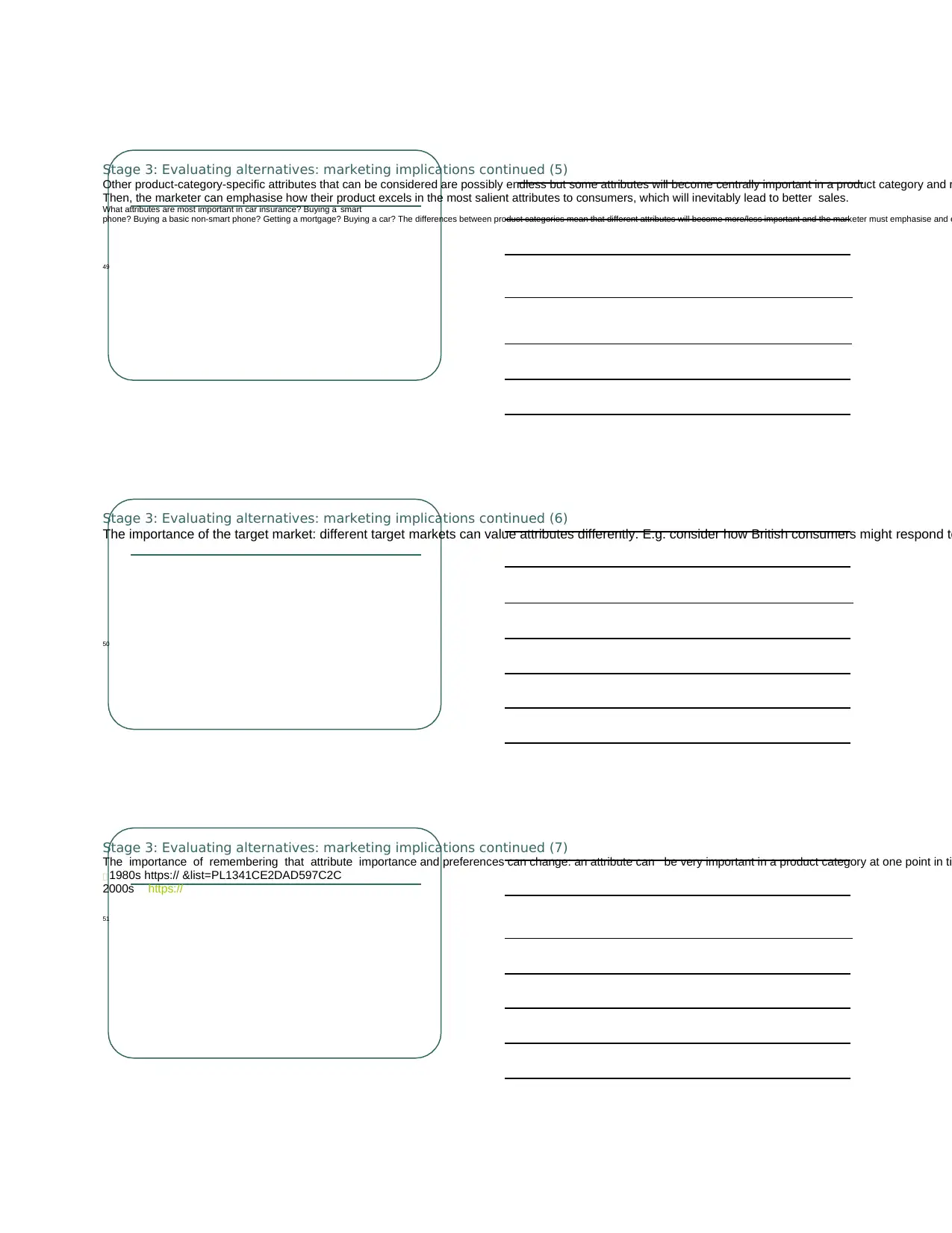
Stage 3: Evaluating alternatives: marketing implications continued (5)
Other product-category-specific attributes that can be considered are possibly endless but some attributes will become centrally important in a product category and r
Then, the marketer can emphasise how their product excels in the most salient attributes to consumers, which will inevitably lead to better sales.
What attributes are most important in car insurance? Buying a smart
phone? Buying a basic non-smart phone? Getting a mortgage? Buying a car? The differences between product categories mean that different attributes will become more/less important and the marketer must emphasise and e
49
Stage 3: Evaluating alternatives: marketing implications continued (6)
The importance of the target market: different target markets can value attributes differently. E.g. consider how British consumers might respond to
50
Stage 3: Evaluating alternatives: marketing implications continued (7)
The importance of remembering that attribute importance and preferences can change: an attribute can be very important in a product category at one point in tim
1980s https:// &list=PL1341CE2DAD597C2C
2000s https://
51
Other product-category-specific attributes that can be considered are possibly endless but some attributes will become centrally important in a product category and r
Then, the marketer can emphasise how their product excels in the most salient attributes to consumers, which will inevitably lead to better sales.
What attributes are most important in car insurance? Buying a smart
phone? Buying a basic non-smart phone? Getting a mortgage? Buying a car? The differences between product categories mean that different attributes will become more/less important and the marketer must emphasise and e
49
Stage 3: Evaluating alternatives: marketing implications continued (6)
The importance of the target market: different target markets can value attributes differently. E.g. consider how British consumers might respond to
50
Stage 3: Evaluating alternatives: marketing implications continued (7)
The importance of remembering that attribute importance and preferences can change: an attribute can be very important in a product category at one point in tim
1980s https:// &list=PL1341CE2DAD597C2C
2000s https://
51
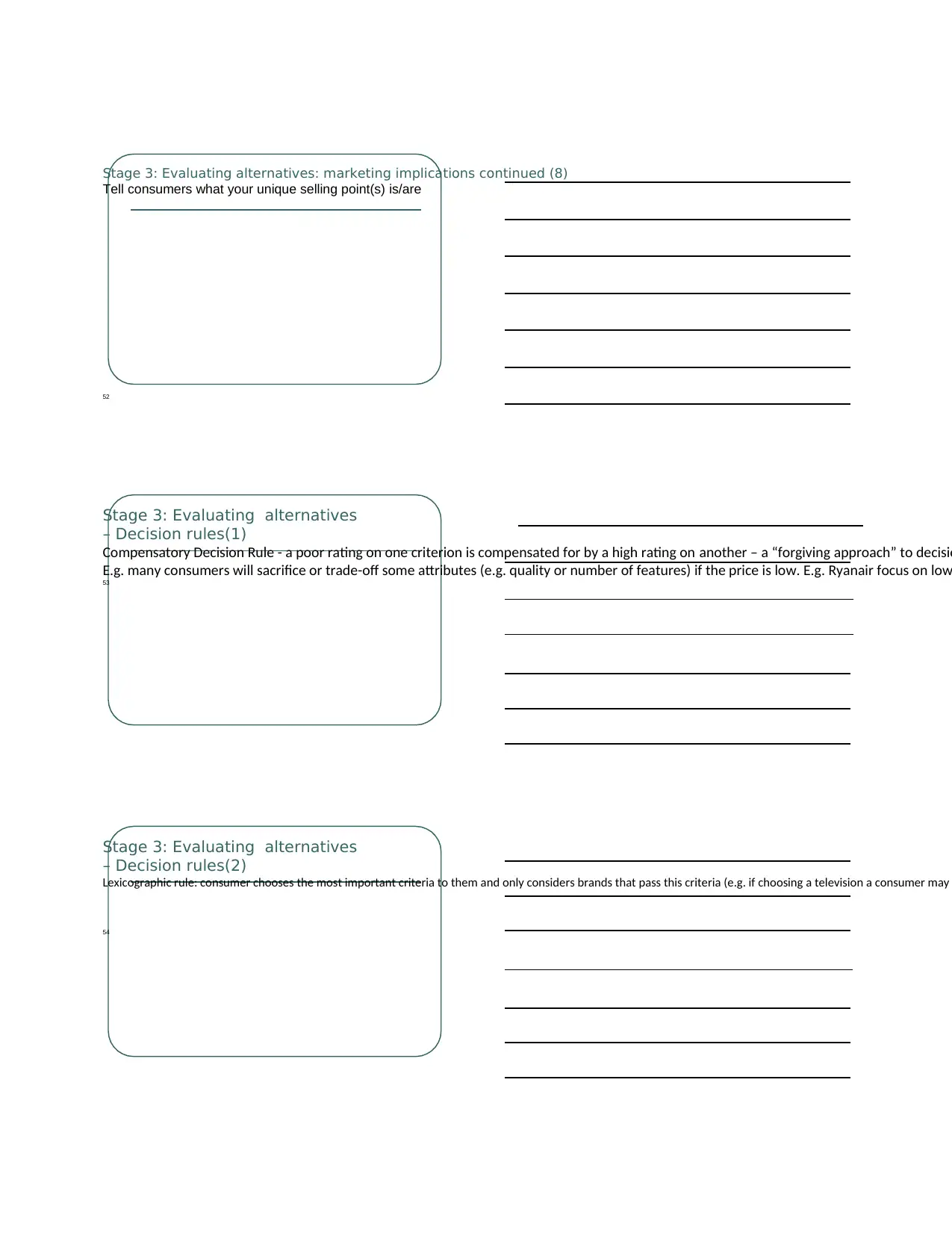
Stage 3: Evaluating alternatives: marketing implications continued (8)
Tell consumers what your unique selling point(s) is/are
52
Stage 3: Evaluating alternatives
– Decision rules(1)
Compensatory Decision Rule - a poor rating on one criterion is compensated for by a high rating on another – a “forgiving approach” to decisio
E.g. many consumers will sacrifice or trade-off some attributes (e.g. quality or number of features) if the price is low. E.g. Ryanair focus on low
53
Stage 3: Evaluating alternatives
– Decision rules(2)
Lexicographic rule: consumer chooses the most important criteria to them and only considers brands that pass this criteria (e.g. if choosing a television a consumer may
54
Tell consumers what your unique selling point(s) is/are
52
Stage 3: Evaluating alternatives
– Decision rules(1)
Compensatory Decision Rule - a poor rating on one criterion is compensated for by a high rating on another – a “forgiving approach” to decisio
E.g. many consumers will sacrifice or trade-off some attributes (e.g. quality or number of features) if the price is low. E.g. Ryanair focus on low
53
Stage 3: Evaluating alternatives
– Decision rules(2)
Lexicographic rule: consumer chooses the most important criteria to them and only considers brands that pass this criteria (e.g. if choosing a television a consumer may
54
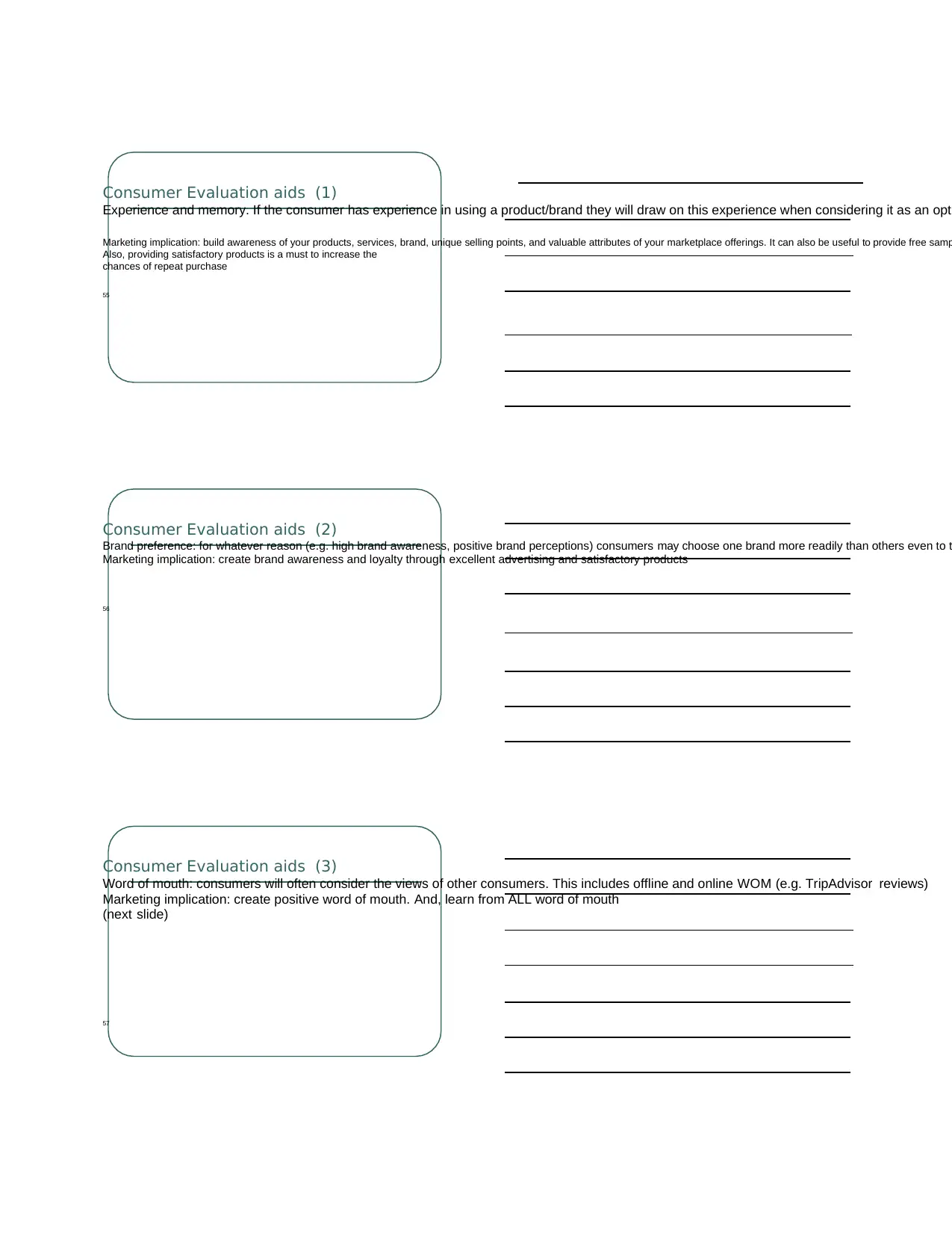
Consumer Evaluation aids (1)
Experience and memory. If the consumer has experience in using a product/brand they will draw on this experience when considering it as an opti
Marketing implication: build awareness of your products, services, brand, unique selling points, and valuable attributes of your marketplace offerings. It can also be useful to provide free samp
Also, providing satisfactory products is a must to increase the
chances of repeat purchase
55
Consumer Evaluation aids (2)
Brand preference: for whatever reason (e.g. high brand awareness, positive brand perceptions) consumers may choose one brand more readily than others even to t
Marketing implication: create brand awareness and loyalty through excellent advertising and satisfactory products
56
Consumer Evaluation aids (3)
Word of mouth: consumers will often consider the views of other consumers. This includes offline and online WOM (e.g. TripAdvisor reviews)
Marketing implication: create positive word of mouth. And, learn from ALL word of mouth
(next slide)
57
Experience and memory. If the consumer has experience in using a product/brand they will draw on this experience when considering it as an opti
Marketing implication: build awareness of your products, services, brand, unique selling points, and valuable attributes of your marketplace offerings. It can also be useful to provide free samp
Also, providing satisfactory products is a must to increase the
chances of repeat purchase
55
Consumer Evaluation aids (2)
Brand preference: for whatever reason (e.g. high brand awareness, positive brand perceptions) consumers may choose one brand more readily than others even to t
Marketing implication: create brand awareness and loyalty through excellent advertising and satisfactory products
56
Consumer Evaluation aids (3)
Word of mouth: consumers will often consider the views of other consumers. This includes offline and online WOM (e.g. TripAdvisor reviews)
Marketing implication: create positive word of mouth. And, learn from ALL word of mouth
(next slide)
57
Paraphrase This Document
Need a fresh take? Get an instant paraphrase of this document with our AI Paraphraser

58
60
Evaluation aids (4)
The Internet: consumers increasingly use the Internet as a part of their evaluation of brands/products/services (e.g. reading a blog or a website/article or even watchin
Marketing implication: many bloggers/reviewers online are ‘for sale’. If paid enough money they will say whatever you want them to say about your product
(see next slide)
http n_2549175745&feature=iv&src_vid=LMU972qncoM&v=2 SrlcTnccAg
59
60
Evaluation aids (4)
The Internet: consumers increasingly use the Internet as a part of their evaluation of brands/products/services (e.g. reading a blog or a website/article or even watchin
Marketing implication: many bloggers/reviewers online are ‘for sale’. If paid enough money they will say whatever you want them to say about your product
(see next slide)
http n_2549175745&feature=iv&src_vid=LMU972qncoM&v=2 SrlcTnccAg
59
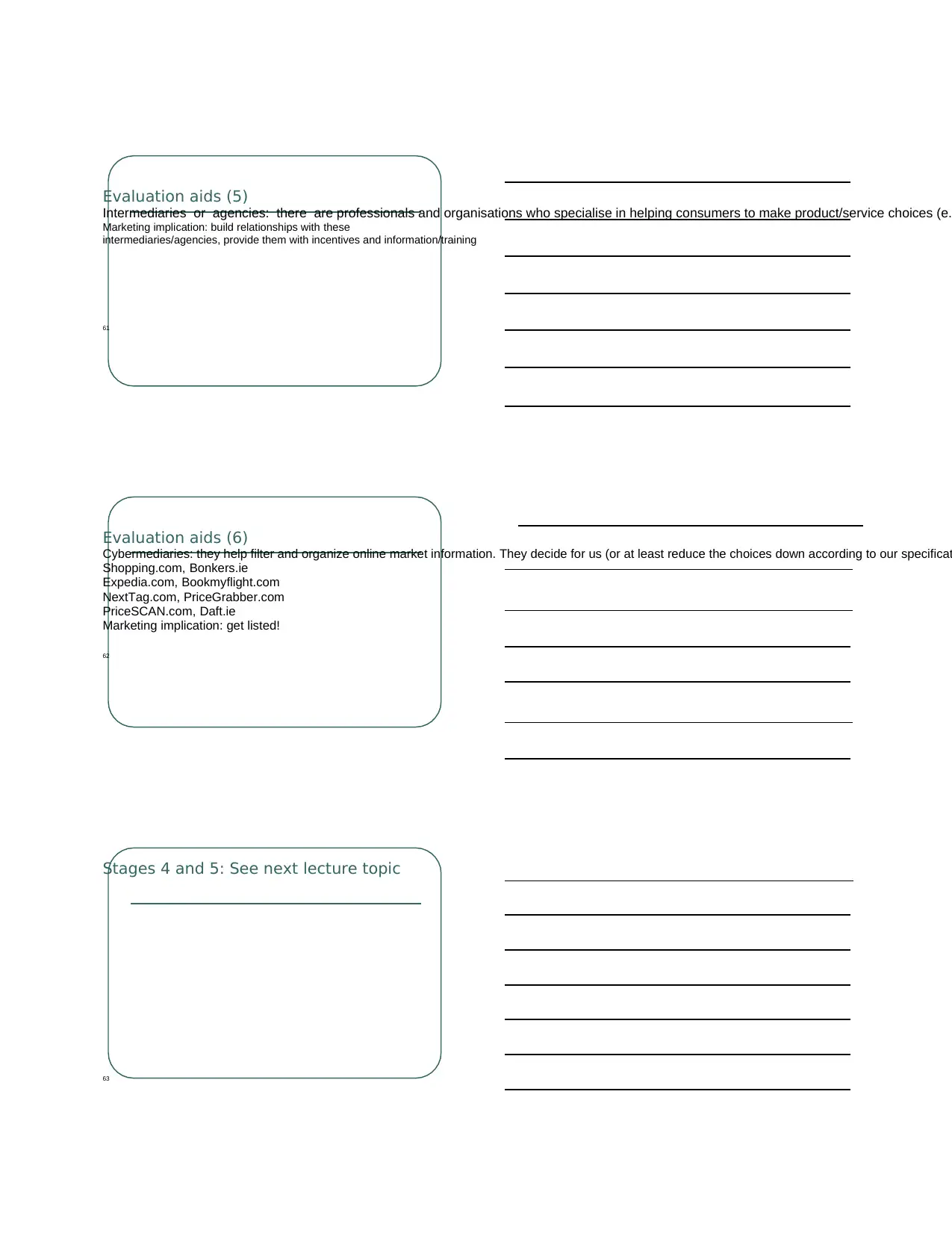
Evaluation aids (5)
Intermediaries or agencies: there are professionals and organisations who specialise in helping consumers to make product/service choices (e.
Marketing implication: build relationships with these
intermediaries/agencies, provide them with incentives and information/training
61
Evaluation aids (6)
Cybermediaries: they help filter and organize online market information. They decide for us (or at least reduce the choices down according to our specificat
Shopping.com, Bonkers.ie
Expedia.com, Bookmyflight.com
NextTag.com, PriceGrabber.com
PriceSCAN.com, Daft.ie
Marketing implication: get listed!
62
Stages 4 and 5: See next lecture topic
63
Intermediaries or agencies: there are professionals and organisations who specialise in helping consumers to make product/service choices (e.
Marketing implication: build relationships with these
intermediaries/agencies, provide them with incentives and information/training
61
Evaluation aids (6)
Cybermediaries: they help filter and organize online market information. They decide for us (or at least reduce the choices down according to our specificat
Shopping.com, Bonkers.ie
Expedia.com, Bookmyflight.com
NextTag.com, PriceGrabber.com
PriceSCAN.com, Daft.ie
Marketing implication: get listed!
62
Stages 4 and 5: See next lecture topic
63
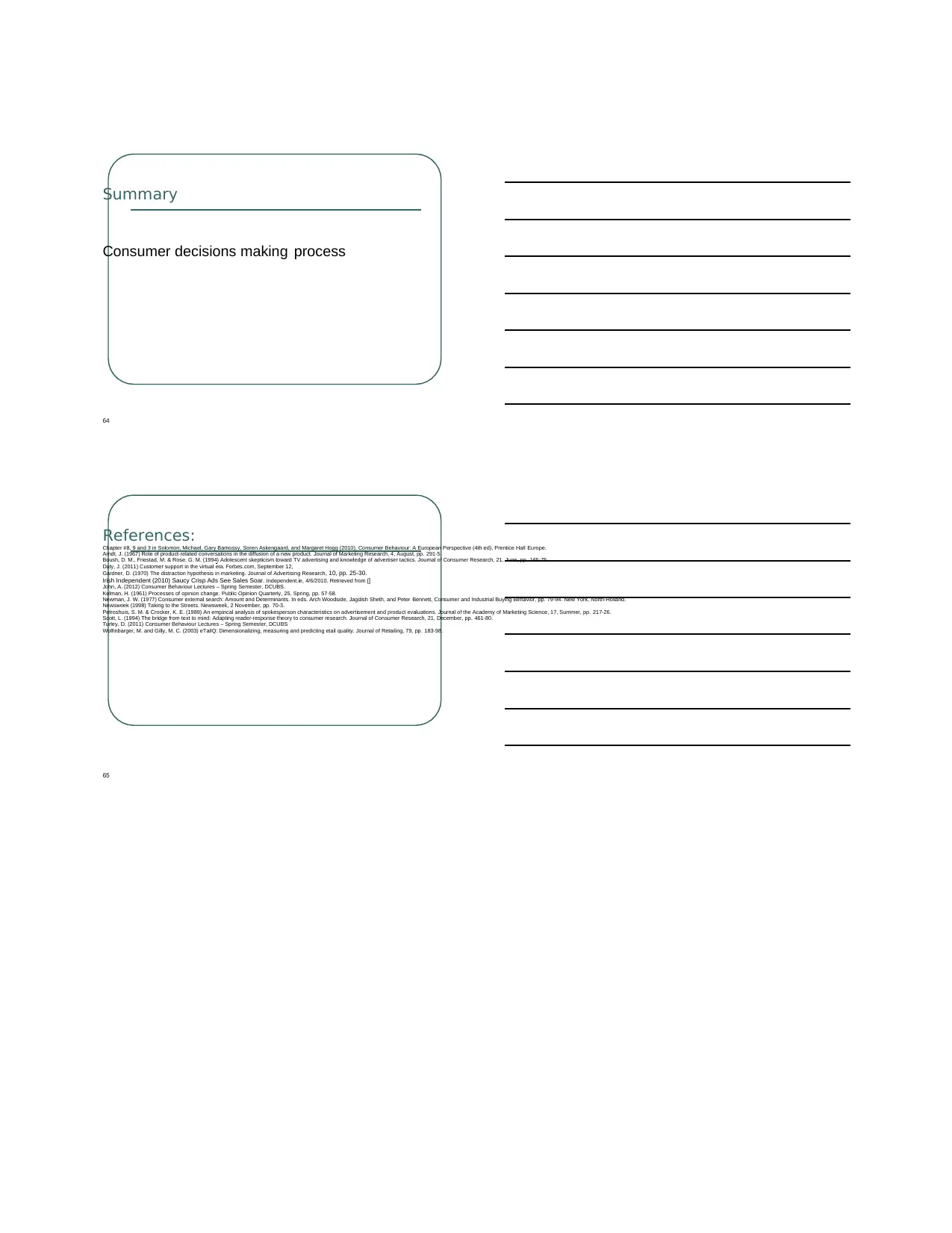
Summary
Consumer decisions making process
64
References:
Chapter #8, 9 and 3 in Solomon, Michael, Gary Bamossy, Soren Askengaard, and Margaret Hogg (2010), Consumer Behaviour: A European Perspective (4th ed), Prentice Hall Europe.
Arndt, J. (1967) Role of product-related conversations in the diffusion of a new product. Journal of Marketing Research, 4, August, pp. 291-5.
Boush, D. M., Friestad, M. & Rose, G. M. (1994) Adolescent skepticism toward TV advertising and knowledge of advertiser tactics. Journal of Consumer Research, 21, June, pp. 165-75.
Duty, J. (2011) Customer support in the virtual era. Forbes.com, September 12,
Gardner, D. (1970) The distraction hypothesis in marketing. Journal of Advertising Research, 10, pp. 25-30.
Irish Independent (2010) Saucy Crisp Ads See Sales Soar. Independent.ie, 4/6/2010. Retrieved from []
John, A. (2012) Consumer Behaviour Lectures – Spring Semester, DCUBS.
Kelman, H. (1961) Processes of opinion change. Public Opinion Quarterly, 25, Spring, pp. 57-58.
Newman, J. W. (1977) Consumer external search: Amount and Determinants. In eds. Arch Woodside, Jagdish Sheth, and Peter Bennett, Consumer and Industrial Buying Behavior, pp. 79-94. New York, North-Holland.
Newsweek (1998) Taking to the Streets. Newsweek, 2 November, pp. 70-3.
Petroshuis, S. M. & Crocker, K. E. (1989) An empirical analysis of spokesperson characteristics on advertisement and product evaluations. Journal of the Academy of Marketing Science, 17, Summer, pp. 217-26.
Scott, L. (1994) The bridge from text to mind: Adapting reader-response theory to consumer research. Journal of Consumer Research, 21, December, pp. 461-80.
Turley, D. (2011) Consumer Behaviour Lectures – Spring Semester, DCUBS
Wolfinbarger, M. and Gilly, M. C. (2003) eTailQ: Dimensionalizing, measuring and predicting etail quality. Journal of Retailing, 79, pp. 183-98.
65
Consumer decisions making process
64
References:
Chapter #8, 9 and 3 in Solomon, Michael, Gary Bamossy, Soren Askengaard, and Margaret Hogg (2010), Consumer Behaviour: A European Perspective (4th ed), Prentice Hall Europe.
Arndt, J. (1967) Role of product-related conversations in the diffusion of a new product. Journal of Marketing Research, 4, August, pp. 291-5.
Boush, D. M., Friestad, M. & Rose, G. M. (1994) Adolescent skepticism toward TV advertising and knowledge of advertiser tactics. Journal of Consumer Research, 21, June, pp. 165-75.
Duty, J. (2011) Customer support in the virtual era. Forbes.com, September 12,
Gardner, D. (1970) The distraction hypothesis in marketing. Journal of Advertising Research, 10, pp. 25-30.
Irish Independent (2010) Saucy Crisp Ads See Sales Soar. Independent.ie, 4/6/2010. Retrieved from []
John, A. (2012) Consumer Behaviour Lectures – Spring Semester, DCUBS.
Kelman, H. (1961) Processes of opinion change. Public Opinion Quarterly, 25, Spring, pp. 57-58.
Newman, J. W. (1977) Consumer external search: Amount and Determinants. In eds. Arch Woodside, Jagdish Sheth, and Peter Bennett, Consumer and Industrial Buying Behavior, pp. 79-94. New York, North-Holland.
Newsweek (1998) Taking to the Streets. Newsweek, 2 November, pp. 70-3.
Petroshuis, S. M. & Crocker, K. E. (1989) An empirical analysis of spokesperson characteristics on advertisement and product evaluations. Journal of the Academy of Marketing Science, 17, Summer, pp. 217-26.
Scott, L. (1994) The bridge from text to mind: Adapting reader-response theory to consumer research. Journal of Consumer Research, 21, December, pp. 461-80.
Turley, D. (2011) Consumer Behaviour Lectures – Spring Semester, DCUBS
Wolfinbarger, M. and Gilly, M. C. (2003) eTailQ: Dimensionalizing, measuring and predicting etail quality. Journal of Retailing, 79, pp. 183-98.
65
1 out of 22
Related Documents
Your All-in-One AI-Powered Toolkit for Academic Success.
+13062052269
info@desklib.com
Available 24*7 on WhatsApp / Email
![[object Object]](/_next/static/media/star-bottom.7253800d.svg)
Unlock your academic potential
© 2024 | Zucol Services PVT LTD | All rights reserved.





